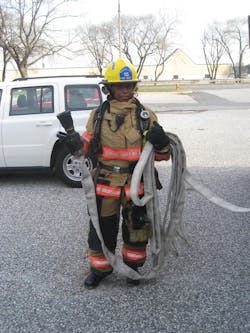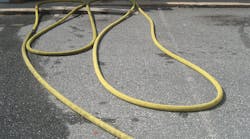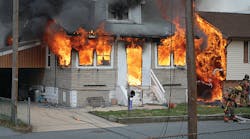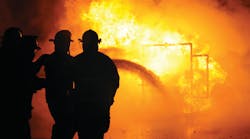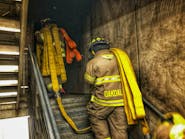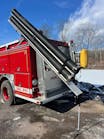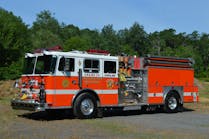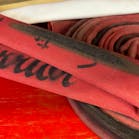The 4 Phases Of the Stretch: Phase 3
So far in this series, we have discussed how to properly prepare ourselves through training and pre-planning. We reviewed how to perform a thorough and accurate size-up and a stretch estimate to ensure an efficient stretch. This article focuses on the necessary elements as well as the procedures and process for making an efficient stretch.
The success of the stretch starts with each member of your engine crew knowing their role and responsibility during the stretch. Some departments have detailed standard operating procedures (SOPs) that clearly define each engine company member’s role. If your department does not have SOPs, then it will be the responsibility of the officer in charge to assign each member of the engine a job before the stretch is performed. If your plan is to assume that the members of your engine know how to make the stretch without any direction, plan or training you are setting yourself and your crew up for failure. Safe and efficient fireground operations don’t happen by chance they happen through consistent and coordinated actions at the scene of a fire
There are many variables to consider when planning your stretch operation. 1st are manning levels. It goes without saying that the number of firefighters performing the stretch will directly impact the success of the stretch. Another variable is the number of lengths in your average stretch. Departments in large and older cities were the average stretch is seven to 10 lengths of hose should be staffed with five or six members. In smaller suburban departments the average stretch may be three or four lengths of hose requiring staffing of three or four members. For many volunteer departments, staffing levels are going to fluctuate depending on the availability of members to respond on calls, but this should not deter you from developing SOPs for making the stretch. Rather, it should reinforce the need to ensure a consistent and coordinated stretch operation.
Developing SOPs
Fireground SOPs are intended to provide a standardized method for the deployment of responding companies to ensure a coordinated effort and eliminate freelancing and duplication of effort. They are designed to give clear direction for WHAT is to be done, WHO is responsible for doing it and WHERE they should be operating on the fireground.
SOPs for engine companies at the scene of a fire include the following basic information:
1. The engine company’s objective at the scene of a fire (WHAT).
• The primary objective of an engine company at the scene of a structure fire is to efficiently and safely stretch and operate the appropriate attack line to extinguish the fire. More lives are saved at the scene of a structure fire by the proper positioning and operating of hoselines than any other fireground tactic.
2. Engine company apparatus position and responsibility (WHERE).
• First-due engine – Front of structure; water supply and primary fire attack
• Second-due engine – Front of structure; secondary water supply and backup primary attack line
• Third-due engine – Rear of structure; water supply and fire attack, floor above fire
• Fourth-due engine – Rear of structure; secondary water supply and fire attack; exposures
3. Engine company members’ riding positions and responsibilities (WHO).
Duties and responsibilities
Each riding position should include a brief description of the duties and responsibilities of the position.
• Officer in charge – No one person will have more influence on the success of the stretch operation than the officer in charge (OIC). That officer’s attitude, experience level and leadership ability set the tone and pace for the engine company at the scene of a fire. Competent and proficient firefighters are a direct reflection of competent and proficient leaders who are committed to training and preparing their firefighters.
While responding to a fire, the OIC and driver should work together to determine the best response route to ensure the engine can secure an effective operating position on the fireground to establish a water source, enhance the stretch operation and allow the truck company a good position close to structure. On arrival, the OIC will conduct a size-up to determine the appropriate strategy and tactics as well as the fire’s location within the structure. Once the size-up is complete, the officer takes command of the stretch operation by ordering the appropriate-size attack line stretched to the appropriate location and position.
• Driver/operator – Once the driver/operator has safely transported the engine and its crew to the scene and secured an effective operating position, he or she will serve a dual role. The first role is to secure a constant water supply for the engine, but the driver/operator also plays an important role when making long stretches (over 200 feet). During long stretches, the backup firefighter will follow the nozzle firefighter to assist with the deployment of the travel hose so the driver/operator must control hose deployment at the engine and ensures the attack line is connected to the appropriate discharge at the completion of the stretch.
• Nozzle firefighter – As soon as the engine arrives on scene, the nozzle firefighter should begin the on-scene size-up and stretch estimate. For this scenario, we are operating at a 2½-story, balloon-constructed, wood-frame dwelling. The stretch estimate reveals that one section, 50 feet of hose, is sufficient to reach a fire on the first floor from the attack entrance at the front of the dwelling (working length) and two sections, 100 feet of hose, will be sufficient to reach the attack entrance from the engine (travel length).
But being familiar with the structures on this street, the nozzle firefighter knows that an additional section of hose, 100 feet of working length, will be needed to reach a fire in the basement or on the second floor. Based on the stretch estimate, the engine’s position and the officer’s orders to stretch a 1¾-inch attack line to the front door for a fire on the second floor, the nozzle firefighter chose to stretch a 200-foot pre-connected crosslay off the driver’s side of the engine (Photo 1). Stretching from this location on the engine will allow for an efficient stretch since it is a straight shot from the engine to the attack entrance (Photo 2).
If we change the engine’s operating position and the location of the fire within the same structure, we see how this information will affect the nozzle firefighter’s decision on which line is the most efficient to stretch. Based on the stretch estimate the engine’s position and the officer’s orders to stretch a 1¾-inch attack line to the rear entrance for a fire on the first floor, the nozzle firefighter chose to stretch a static line off the rear step (Photo 3.) Knowing the crew would not need all of the hose in the pre-connected attack line, based on the stretch estimate, the nozzle firefighter chose to stretch a static line to allow the flexibility of stretching only the hose needed to avoid overstretching. Stretching off the rear of the engine allowed for the most efficient stretch, since it is the most direct route from the engine to the attack entrance (Photo 4).
The nozzle firefighter starts the stretch by removing the necessary working length and heading for the attack entrance (Photo 5). The nozzle firefighter must remember not to deploy the hose in the working length to reach the attack entrance or the line will be stretched short of the fire (Photo 6). Once the nozzle firefighter arrives at the attack entrance, he then deploys the hose in the working length and stages it in line with the attack entrance for a smooth advance. He places the coupling of the first length close to the door to guarantees 50 feet of working length from the attack entrance. He then places the next coupling as close to the attack entrance as possible for a total of 100 feet of hose to reach the fire on the second floor (Photo 7).
• Backup firefighter – The backup firefighter should also be conducting a size-up and a stretch estimate on arrival. Performing the stretch is done as a team and your partner and you should be communicating and working together. The backup firefighter’s duties and responsibilities are always the same, but how you get the job done will be affected by the engine’s position, the length of the stretch and the type of line deployed. If your stretch estimate reveals that your pre-connected line is the best option, make sure all hose is deployed from the hosebed. When stretching a static line, deploy only the necessary amount of travel hose needed based on your stretch estimate. Also make sure the attack line is hooked to a discharge and advise the driver of the total length of your stretch (Photo 8).
During long stretches, the backup firefighter will deploy travel hose and follow the nozzle firefighter to ensure the working length and nozzle reach the attack entrance (Photo 10). For shorter stretches, where you have good line of sight of the attack entrance and the nozzle firefighter performing the stretch, the backup firefighter can stay at the engine and deploy hose (Photo 9). The exceptions to this are stretches where you have numerous obstacles to navigate. For these difficult stretches, you will have to follow the nozzle firefighter to ensure he arrives at the attack entrance regardless of the length of the stretch. Once the nozzle firefighter reaches the attack entrance, it will be your responsibility to chase out the kinks and snags in the hose as well as properly position and stage the hose between the engine and the working length.
Conclusion
The more attention to detail we can give to mastering the art of the stretch the better our chances of making a safe and efficient advance on the fire. All of our training and preparation are about to pay off. We are about to embark on the most dangerous and rewarding part of our job. The fourth and final installment of this series focuses on the importance of making a quick and safe advance to extinguish the fire.
For more about fire service training, visit: http://www.firehouse.com/topics/training.
BRYAN T. SMITH has been a member of the fire service for 30 years. He started as a volunteer firefighter with the Lutherville, MD, Volunteer Fire Company and in 1987, he was hired as a career firefighter with the Baltimore County Fire Department, where he currently holds the rank of captain at Station 15. Smith is a nationally certified fire service instructor and has served as an adjunct instructor at the Baltimore County Fire Rescue Academy and a lead instructor with Realistic Training Solutions LLC.
Bryan T. Smith
BRYAN T. SMITH has been a member of the fire service for 30 years. He started as a volunteer firefighter with the Lutherville, MD, Volunteer Fire Company and in 1987, he was hired as a career firefighter with the Baltimore County Fire Department, where he currently holds the rank of captain at Station 15. Smith is a nationally certified fire service instructor and has served as an adjunct instructor at the Baltimore County Fire Rescue Academy and a lead instructor with Realistic Training Solutions LLC.
